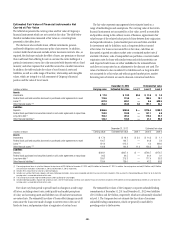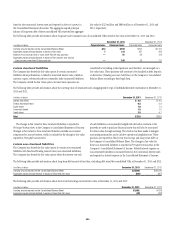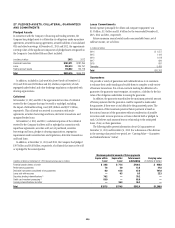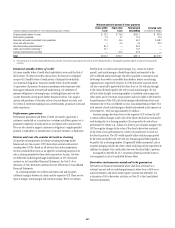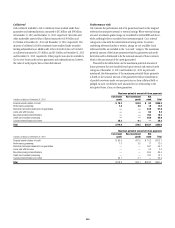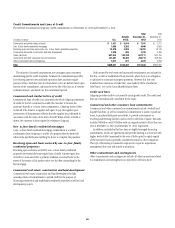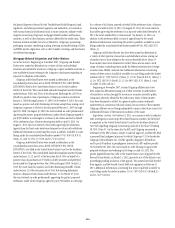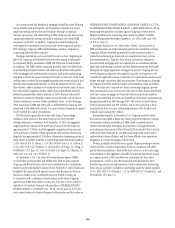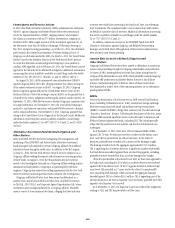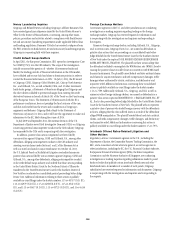Citibank 2013 Annual Report Download - page 317
Download and view the complete annual report
Please find page 317 of the 2013 Citibank annual report below. You can navigate through the pages in the report by either clicking on the pages listed below, or by using the keyword search tool below to find specific information within the annual report.299
Custody indemnifications
Custody indemnifications are issued to guarantee that custody clients will
be made whole in the event that a third party subcustodian or depository
institution fails to safeguard clients’ assets.
Other guarantees and indemnifications
Credit Card Protection Programs
Citi, through its credit card businesses, provides various cardholder protection
programs on several of its card products, including programs that provide
insurance coverage for rental cars, coverage for certain losses associated with
purchased products, price protection for certain purchases and protection
for lost luggage. These guarantees are not included in the table, since the
total outstanding amount of the guarantees and Citi’s maximum exposure
to loss cannot be quantified. The protection is limited to certain types of
purchases and losses, and it is not possible to quantify the purchases that
would qualify for these benefits at any given time. Citi assesses the probability
and amount of its potential liability related to these programs based on the
extent and nature of its historical loss experience. At December 31, 2013 and
December 31, 2012, the actual and estimated losses incurred and the carrying
value of Citi’s obligations related to these programs were immaterial.
Other Representation and Warranty Indemnifications
In the normal course of business, Citi provides standard representations
and warranties to counterparties in contracts in connection with numerous
transactions and also provides indemnifications, including indemnifications
that protect the counterparties to the contracts in the event that additional
taxes are owed due either to a change in the tax law or an adverse
interpretation of the tax law. Counterparties to these transactions provide Citi
with comparable indemnifications. While such representations, warranties
and indemnifications are essential components of many contractual
relationships, they do not represent the underlying business purpose for the
transactions. The indemnification clauses are often standard contractual
terms related to Citi’s own performance under the terms of a contract and
are entered into in the normal course of business based on an assessment
that the risk of loss is remote. Often these clauses are intended to ensure
that terms of a contract are met at inception. No compensation is received
for these standard representations and warranties, and it is not possible to
determine their fair value because they rarely, if ever, result in a payment.
In many cases, there are no stated or notional amounts included in the
indemnification clauses, and the contingencies potentially triggering the
obligation to indemnify have not occurred and are not expected to occur.
As a result, these indemnifications are not included in the tables above.
Value-Transfer Networks
Citi is a member of, or shareholder in, hundreds of value-transfer networks
(VTNs) (payment, clearing and settlement systems as well as exchanges)
around the world. As a condition of membership, many of these VTNs require
that members stand ready to pay a pro rata share of the losses incurred by
the organization due to another member’s default on its obligations. Citi’s
potential obligations may be limited to its membership interests in the VTNs,
contributions to the VTN’s funds, or, in limited cases, the obligation may
be unlimited. The maximum exposure cannot be estimated as this would
require an assessment of future claims that have not yet occurred. Citi
believes the risk of loss is remote given historical experience with the VTNs.
Accordingly, Citi’s participation in VTNs is not reported in the guarantees
tables above, and there are no amounts reflected on the Consolidated Balance
Sheet as of December 31, 2013 or December 31, 2012 for potential obligations
that could arise from Citi’s involvement with VTN associations.
Long-Term Care Insurance Indemnification
In the sale of an insurance subsidiary, the Company provided an
indemnification to an insurance company for policyholder claims and
other liabilities relating to a book of long-term care (LTC) business (for the
entire term of the LTC policies) that is fully reinsured by another insurance
company. The reinsurer has funded two trusts with securities whose fair
value (approximately $5.4 billion at December 31, 2013, compared to
$4.9 billion at December 31, 2012) is designed to cover the insurance
company’s statutory liabilities for the LTC policies. The assets in these trusts
are evaluated and adjusted periodically to ensure that the fair value of the
assets continues to cover the estimated statutory liabilities related to the LTC
policies, as those statutory liabilities change over time.
If the reinsurer fails to perform under the reinsurance agreement for any
reason, including insolvency, and the assets in the two trusts are insufficient
or unavailable to the ceding insurance company, then Citi must indemnify
the ceding insurance company for any losses actually incurred in connection
with the LTC policies. Since both events would have to occur before Citi
would become responsible for any payment to the ceding insurance company
pursuant to its indemnification obligation, and the likelihood of such events
occurring is currently not probable, there is no liability reflected in the
Consolidated Balance Sheet as of December 31, 2013 and December 31, 2012
related to this indemnification. Citi continues to closely monitor its potential
exposure under this indemnification obligation.
Carrying Value—Guarantees and Indemnifications
At December 31, 2013 and December 31, 2012, the total carrying amounts
of the liabilities related to the guarantees and indemnifications included in
the tables above amounted to approximately $1.3 billion and $3.2 billion,
respectively. The decrease in the carrying value is primarily related to certain
derivative instruments where Citi obtained additional contract level details
during the second quarter of 2013, resulting in some of these contracts no
longer being considered guarantees for disclosure purposes by Citi. Derivative
instruments are included at fair value in either Trading account liabilities
or Other liabilities, depending upon whether the derivative was entered into
for trading or non-trading purposes. The carrying value of financial and
performance guarantees is included in Other liabilities. For loans sold with
recourse, the carrying value of the liability is included in Other liabilities.




